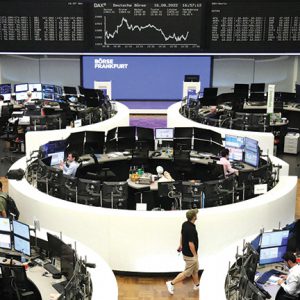Bloomberg
European stocks advance, while US index futures and Asian equities fell, as investors hunted for pockets of value amid hawkish central banks, disappointing earnings and further power consolidation in China.
The dollar gained before data on the Federal Reserve’s preferred inflation measure. The Stoxx Europe 600 Index climbed for a second day. Contracts on the S&P 500 and Nasdaq 100 slipped at least 0.2% each. Chinese technology stocks led a selloff in Asia amid signs price wars and cash burns are undermining profits. The yen drifted lower after the nominee for the Bank of Japan’s top job signalled continuity of loose monetary policy.
Traders are contending with a complicated investment landscape as they navigate the era of tighter monetary policy. The risks surrounding central banks’ continued fight against inflation are compounded by decelerating growth and corporate performance, growing geopolitical tensions from
Russia to North Korea, and
regulatory curbs in China.
“Rising tensions certainly increase the safe haven flows to the US Treasuries and interfere with the hawkish Fed pricing,†Ipek Ozkardeskaya, a senior analyst at Swissquote Bank, wrote in a note.
Europe’s Stoxx 600 gauge rose for a second day, almost erasing its weekly losses, as investors continued to show a preference for the region known for value stocks over the US or China where growth equities are more dominant. Energy and construction companies were the best-performing industry groups on the benchmark index.
A gauge of Chinese technology stocks listed in Hong Kong tumbled 3.3%. NetEase Inc. slumped after a profit miss, while Alibaba Group Holding Ltd. fell as analysts remained cautious about its sales growth prospect. Meanwhile, Chinese President Xi Jinping was set to bring decision-making of the financial system further under his control with the revival of a powerful committee.
The dollar advanced for the third time in four days before Friday’s release of the personal consumption expenditures index — the Fed’s preferred price gauge — which is expected to show acceleration amid robust income and spending growth. Treasuries were mixed.
German yields slipped after gross domestic product in Europe’s biggest economy contracted 0.4% in the fourth quarter, more than expected.
In commodities, oil extended on Thursday’s advance, when it snapped its longest losing streak since December amid strength in commodity currencies and signs of appetite for risk taking.
Bitcoin was on pace for its second monthly advance, breaking with stocks and other riskier assets that have slid amid renewed concern about rising interest rates.
The Stoxx Europe 600 rose 0.4% as of 8:43 am London time and S&P 500 futures fell as much as 0.2%.
While Nasdaq 100 futures fell 0.5%, futures on the Dow Jones Industrial Average fell 0.1% and the MSCI Asia Pacific Index fell 0.6%. The MSCI Emerging Markets Index also drops as much as 1.3%.
The Bloomberg Dollar Spot Index rose 0.1% and the euro was little changed at $1.0594.
While the Japanese yen fell 0.1% to 134.88 per dollar, the offshore yuan fell 0.5% to 6.9527 per dollar and the British pound rose 0.2% to $1.2039.
The yield on 10-year Treasuries was little changed at 3.88% and Germany’s 10-year yield declined three basis points to 2.45%. Britain’s 10-year yield declined three basis points to 3.56%.
 The Gulf Time Newspaper One of the finest business newspapers in the UAE brought to you by our professional writers and editors.
The Gulf Time Newspaper One of the finest business newspapers in the UAE brought to you by our professional writers and editors.
